Bulletin – April 1999 Recent Developments in Interest Rates on Bank Lending
- Download 60KB
Introduction
In implementing monetary policy, the Bank uses changes in the overnight interest rate on money market funds – the so-called cash rate – to influence the interest rate structure in the economy more generally, particularly the interest rates charged by intermediaries on loans. These interest rates normally move broadly in line with the cash rate, but in recent years they have fallen by significantly more as competition among intermediaries has seen them cut their interest margins. Whereas the cash rate has fallen by 2.75 percentage points since mid 1996, to its previous cyclical low of 1993/94, intermediaries' interest rates have fallen by as much as 5 percentage points, to levels not seen since the early 1970s (Graph 1). The compression of margins accompanying the easing of monetary policy over the past three years or so has worked to augment the stimulative effect of the policy moves.
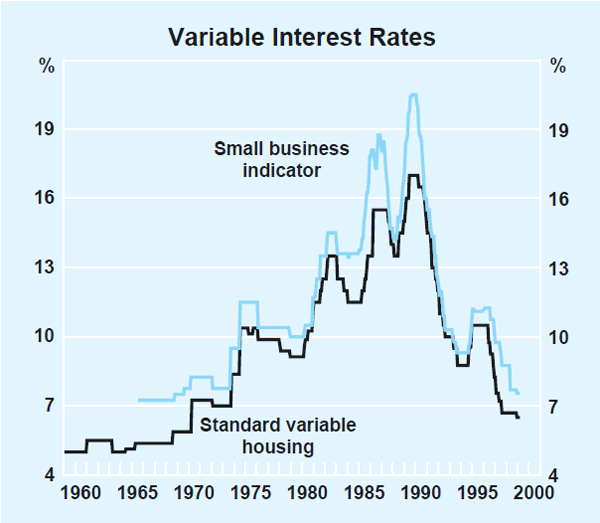
This article outlines how intermediaries' interest rates have moved on the major types of lending: housing loans, personal loans and business loans.
Households
Housing
The ‘competitive’ reductions in interest rates first became evident – and have been most pronounced – in the housing lending market. Since the previous cyclical peak in mid 1996, interest rates on standard variable-rate housing loans have fallen by 4 percentage points – 1¼ percentage points more than the reduction in the cash rate; the average interest rate charged by banks on standard-variable housing loans is now 6.5 per cent. Mortgage managers' lending rates are slightly below those of banks (Table 1).
| Change from June quarter 1996 to March 1999 |
Current level |
|
|---|---|---|
| Percentage points |
Per cent | |
| Banks | ||
| Standard variable | −4.00 | 6.50 |
| Basic | −3.05 | 5.90 |
| Mortgage managers | ||
| Standard variable | −2.80 | 6.10 |
| Basic | .. | 5.75 |
| Cash rate | −2.75 | 4.75 |
The contraction in housing margins owes much to the return of low inflation in Australia in the 1990s. The resulting fall in interest rates in wholesale markets significantly reduced the cost advantage banks had (relative to other potential lenders) which was based on banks' ability to fund themselves from a large pool of relatively cheap retail deposits, including non-interest bearing current accounts. The reduction in market interest rates established a precondition for new groups of lenders – such as mortgage managers – to undercut the margin that banks had been earning on standard housing loans. This margin was 4 percentage points above the cash rate in the mid 1990s. In effect, the fall in interest rates in wholesale markets early in the 1990s meant that mortgage managers could raise funds in these markets at rates competitive with banks' average cost of funds (Graph 2).
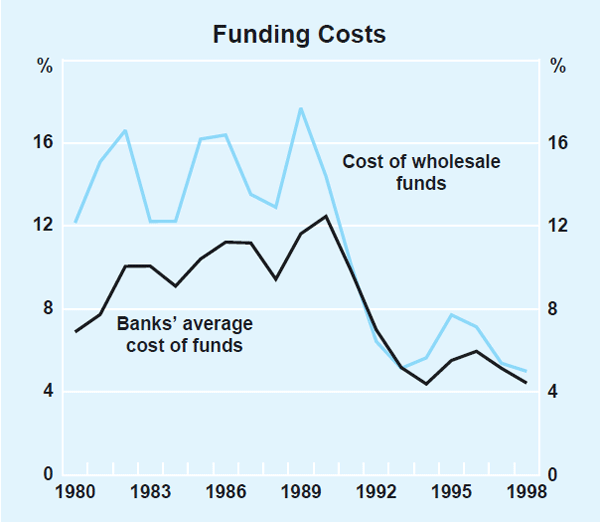
While banks' average funding costs have remained slightly lower than mortgage managers', the latter group does not incur the substantial overheads of branch networks associated with running a retail deposit operation. By pricing housing loans at a spread of around 1.25–1.5 percentage points above the cost of issuing bills (their main source of funding), mortgage managers covered operating costs but also undercut banks on price (Graph 3). They gained considerable market share in the process: in the two years to June 1996, banks' share of owner-occupied housing approvals fell by almost 10 percentage points to a little over 80 per cent, due to competition from mortgage managers.
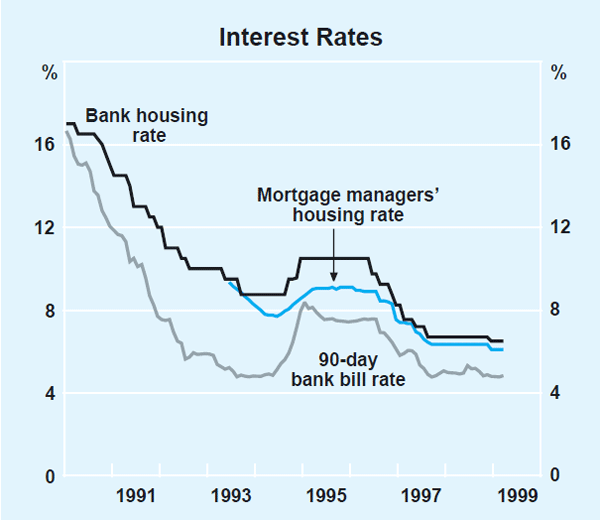
Banks initially responded to this challenge by cutting interest rates on loans available to new borrowers, either by introducing ‘honeymoon’ loans or making other special offers. They also introduced ‘basic’ products which carried a lower interest rate than the standard variable rate but which did not have all of the options available with the standard loan. Banks' existing customers, however, increasingly began to refinance their loans with the lower-cost mortgage managers: by late 1995, about half of mortgage managers' total approvals were loans refinanced from other lenders.
These competitive pressures eventually saw banks cut interest rates charged on loans of existing borrowers too. In June 1996, banks cut standard variable rates by around 75 basis points, independently of any move in monetary policy. A similar ‘competitive’ cut was made in February 1997, when banks reduced their standard rates by 70 basis points. This cut largely closed the gap between the interest rate on banks' standard variable-rate loans and mortgage managers' rates. Banks subsequently recaptured a good deal of the market share they had previously lost.
These reductions in interest rates have seen margins on standard housing loans fall to about 1.75 percentage points above the cash rate. By early in 1997, margins on housing loans in Australia had come into line with the average experience of other English-speaking countries (Graph 4).
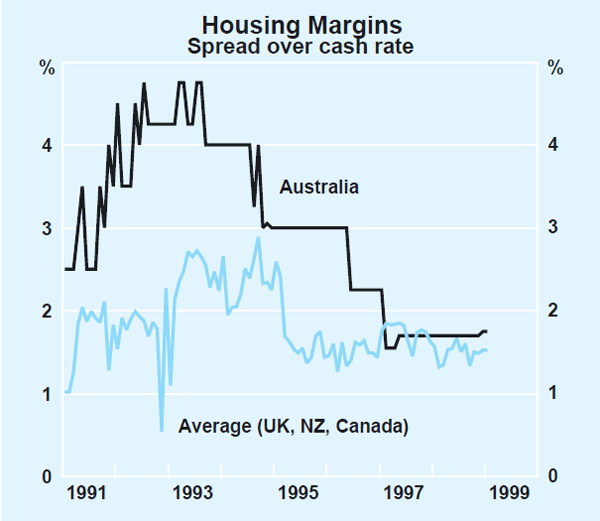
Personal loans
Competition in the market for personal loans has been more selective than in the housing market, and came somewhat later. As in the housing lending market and the small business market (see below), new low-cost products have been introduced, in particular those which give explicit recognition to security on residential property. Movements in selected personal lending rates are summarised in Table 2.
| Change from June quarter 1996 to March 1999 |
Current level |
|
|---|---|---|
| Percentage points |
Per cent | |
| Secured | ||
| Instalment loan | −2.15 | 9.30 |
| Revolving line of credit | −4.90 | 6.60 |
| Unsecured | ||
| Instalment loan | −2.00 | 11.50 |
| Credit cards – With interest-free period |
−1.40 | 15.30 |
| – Without interest-free period | −2.25 | 13.70 |
| Cash rate | −2.75 | 4.75 |
The largest reduction in interest rates has occurred in residentially secured revolving lines of credit, or ‘home equity’ loans (Graph 5). This is the only form of personal lending where interest rates have fallen further than the cash rate. These loans are much more flexible than traditional personal loans, with borrowers able to repay and redraw against a previously approved limit, more or less as they please. To facilitate such flexibility, ‘home equity’ loans often incorporate payment facilities, such as credit cards or cheque books. Such loans enable households to draw on the equity accumulated in their dwellings, either to spend on consumer goods and services or to acquire other assets such as shares. The contraction in margins on home equity loans exceeds the fall in margins on housing loans, mainly because the former were originally priced at a rate well above standard mortgages. This gap has now largely been eliminated, with home equity loans now available at an interest rate of 6.6 per cent, only 10 basis points above the rate on banks' standard housing loans. This is consistent with a general move by banks toward recognising explicitly the quality of collateral offered by borrowers. This, as discussed below, is also evident in the small business market.
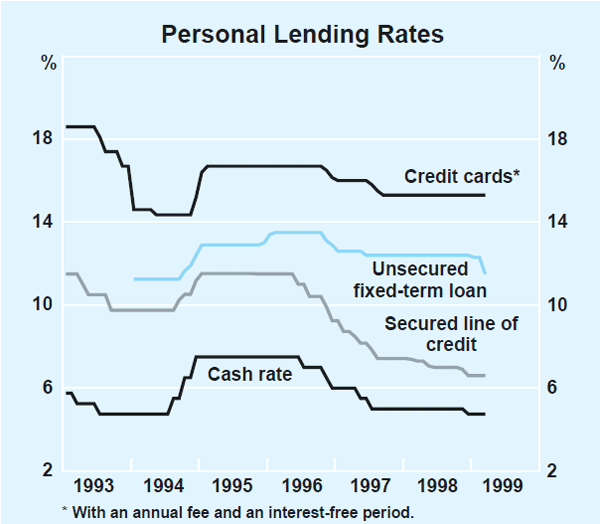
Interest rates on traditional personal lending products, such as instalment loans and credit cards, have fallen by less than the cash rate since the peak in 1996, with margins widening in recent years. The margin on credit card rates fell steadily in the first half of the 1990s from about 15 percentage points to about 8 percentage points by 1994; this move has since been partially reversed. The interest rate on credit cards (with an interest-free period) is now more than 10 percentage points above the cash rate. The wider margin has been achieved by banks holding interest rates on credit cards relatively steady while the cash rate has been reduced. The spread on credit-card interest rates in Australia is comparable with that in the United States but below that in Canada and New Zealand (Graph 6). (Statistics are not readily available for the United Kingdom or other European countries.)
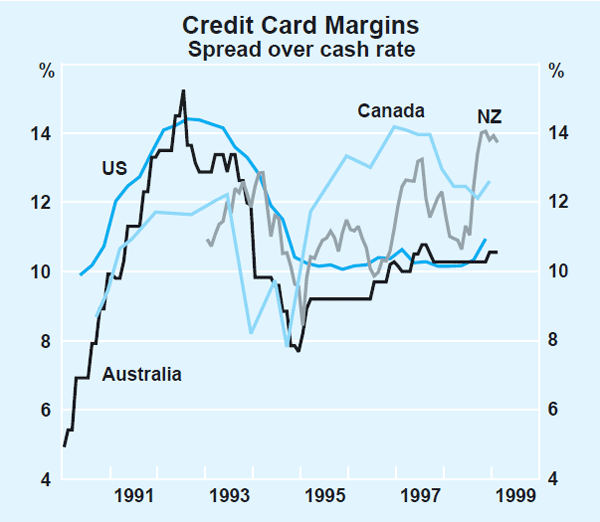
This wide margin does not affect all who borrow on credit cards, since most borrowing is on cards with an interest-free period. Many borrowers use credit cards exclusively as a device to make payments, taking advantage of various ‘loyalty’ programs, and repaying the balance of their account in full each month. Such borrowers would incur no interest costs. For borrowers who use credit cards as part of a ‘home equity’ loan, credit card balances are swept to the much lower-cost ‘home equity’ loan at the end of each month. For remaining customers, who use credit cards as a personal loan, the widening of margins on credit cards represents an effective increase in costs.
Notwithstanding the fact that the pass-through of cash rate cuts has been less complete on some personal loans than on either housing or business loans, growth in overall personal lending has increased more quickly than other categories of lending (Graph 7). Growth has been concentrated in secured revolving lines of credit, as discussed, as well as in credit card loans. The latter partly reflects the success of loyalty programs but may also reflect borrowing via low-cost credit cards available with ‘home equity’ loans.
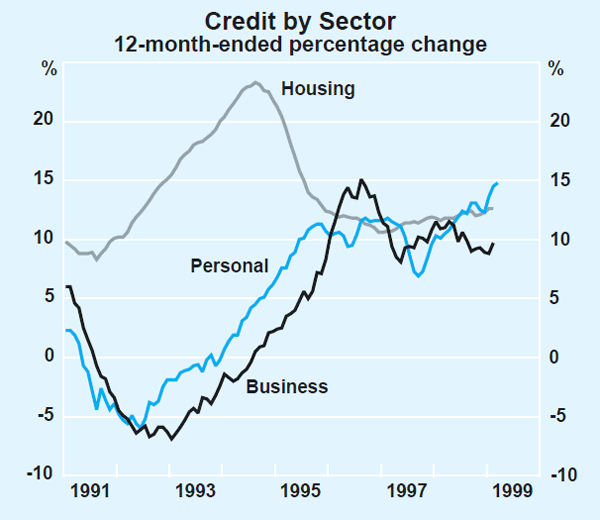
Small Business Lending
The heightened competition in mortgage markets caused banks to reassess their lending strategies more generally, resulting in intensified competitive pressures in the market for small business lending.
As with housing, banks initially offered discounts on standard products to new borrowers. By mid 1996, however, at least one bank began to introduce variable-rate products – both term loans and overdrafts – which gave explicit recognition to the security of residential property. When introduced, these residential-secured loans were at a slight discount to traditional overdrafts (Graph 8). Most banks were slower to follow suit, maintaining competitive discounts only for new borrowers. However, competitive pressures spread more widely early in 1997, when a number of major banks cut indicator rates on residentially secured small business loans by up to 2 percentage points for all borrowers, independent of any change in the stance of monetary policy, and ceased to apply customer risk margins to these loans.
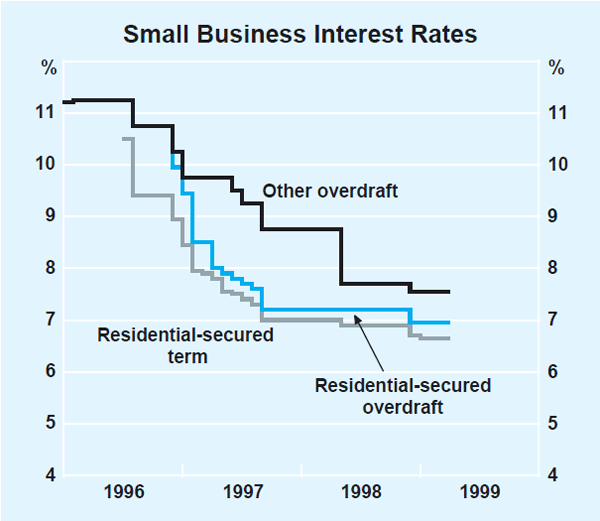
In early 1998, a group of major banks cut small business indicator rates more generally, again without a change in the cash rate. At the same time, some banks also announced fixed risk margins for loans secured by commercial property or business assets. This was a departure from the traditional approach to pricing such loans, whereby banks had previously charged a standard indicator rate plus an individual customer risk margin.
A result of these moves is that there is a diversity of loan products now on offer to small businesses, with a range of different indicator rates and banks pricing credit risk in different ways – some pricing at fixed margins according to security offered by borrowers, others according to individual customer risk margins. Accordingly, no single rate is now representative of the indicator interest rate to small business. Average indicator rates now charged by banks on a range of products are summarised in Table 3.
| Change from June quarter 1996 to March 1999 |
Current level |
|
|---|---|---|
| Percentage points |
Per cent | |
| Small business | ||
| Overdrafts – Residential-secured |
−4.90 | 6.95 |
| – Other security(a) | −3.70 | 7.55 |
| Term loans – Residential-secured |
−3.85 | 6.65 |
| – Other security(a) | −4.10 | 7.15 |
| Large business | ||
| Overdrafts | −2.85 | 7.95 |
| Term loans | −2.90 | 7.90 |
| Cash rate | −2.75 | 4.75 |
| (a) Including unsecured. | ||
A comprehensive measure of the overall interest rate paid by small businesses is the weighted-average interest rate on small business loans, which comes from the Reserve Bank's quarterly Business Finance Survey. This measure includes indicator rates charged by banks, plus risk margins as applicable.
The weighted-average interest rate paid on variable-rate loans by small businesses was 8.7 per cent in December 1998, down from 12.6 per cent in June 1996. While the pass-through of the December easing of monetary policy was faster than previous announcements, a further small decline in this rate may be in prospect. At this stage, the rate has fallen by about 1.1 percentage points more than the cash rate since mid 1996.
The role of new products in this development is evident from Graph 9, which shows the distribution of interest rates paid by small businesses on variable-rate loans (excluding bills). As would be expected with the reduction in the cash rate, this distribution has shifted to the left. However, another important feature is that the interest rate most commonly paid by small businesses is now between 6 and 7 per cent. Rates at this level are only generally available on residentially secured loans, suggesting a significant amount of small business funding has moved towards this product. In mid 1996, the rate most-commonly paid by small businesses was between 13 and 14 per cent; in June 1994, when the cash rate was also – as now – 4.75 per cent, this rate was between 11 and 12 per cent.
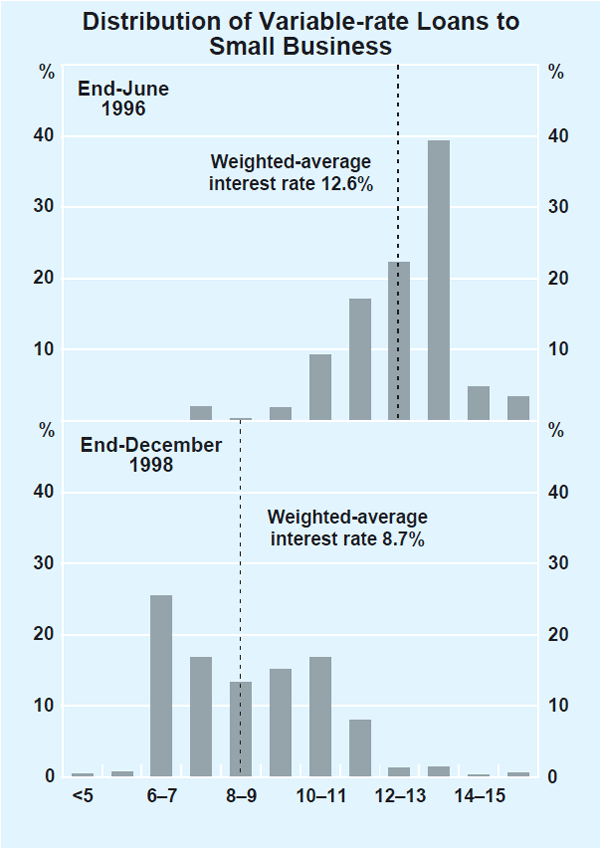
It is difficult to make judgments about whether, at these levels, margins on small business loans are comparable with those in other countries, mainly because hard data on the total interest rate on small business loans are not published in many countries. Some statistics are available for the United States, which suggest that margins in Australia have moved closer to those in the US (Table 4). For example, for loans of less than $100,000 in both countries, the margin of the total interest rate above the respective policy rate – the cash rate in Australia, the Fed funds rate in the US – is a little over 4 per cent. For ‘larger’ small business loans, margins in Australia might still be a little wider than in the United States.
| June 1997 | December 1998 |
|
|---|---|---|
| Percentage points | ||
| Loans under $100,000 | ||
| Australia | 5.1 | 4.1 |
| United States | 4.3 | 4.1 |
| ‘Larger’ small business loans | ||
| Australia – $100,000 to $500,000 |
4.4 | 3.6 |
| – $500,000 to $2 million | 4.0 | 3.3 |
| United States – $100,000 to $1 million |
3.3 | 3.1 |
|
(a) Variable and fixed-rate loans, excluding bills. New loans for the US; outstanding loans for Australia. Sources: RBA, Business Finance Statistics; US Federal Reserve, Survey of Terms of Business Lending. |
||
Survey evidence from the UK suggests that small business loans are generally priced at a spread of around 3–4 percentage points above the policy rate.
Indicator interest rates on products available to large businesses have fallen by less than for small businesses. At the same time, as discussed in ‘The Economy and Financial Markets’ in the Bulletin of February 1999, widespread discounting is apparent in the interest rates banks charge large businesses for variable-rate loans; the weighted-average interest rate on these borrowings currently is about 0.3 of a percentage point below the indicator rate. Such loans, however, represent a relatively small proportion of bank loans to large business, the bulk of which occurs via bill facilities, at fine spreads to yields in wholesale markets. There has, accordingly, been much less scope to trim margins on such lending.
Conclusion
Intermediaries' lending rates have fallen from a cyclical peak in 1996, to levels that are as low as they have been since the early 1970s. These reductions reflect two components: the easing of monetary policy since 1996, as reflected in the cut in the cash rate of 2.75 percentage points; and, reductions in margins across a range of household and business loan products.
The first component reflects policy decisions made on the basis of the outlook for inflation and economic activity. The second component reflects competitive pressures in lending markets, which have emerged partly as a result of the return to low inflation in Australia in the 1990s. The reductions in lending rates have brought lending margins more into line with margins in comparable countries.
Given the likelihood of continuing intense competitive pressures in these markets, this compression of margins is unlikely to be a mere cyclical phenomenon, apt to be reversed when the interest rate cycle turns. In other words, these reductions, while unlikely to be repeated, seem likely to be permanent. One factor in this is the willingness of households and business to switch their borrowing to take advantage of the most attractive rates on offer.
Whatever the mechanism, the ‘competitive’ reductions in interest rates have worked to reinforce the supportive part played by monetary policy in promoting economic growth in recent years.